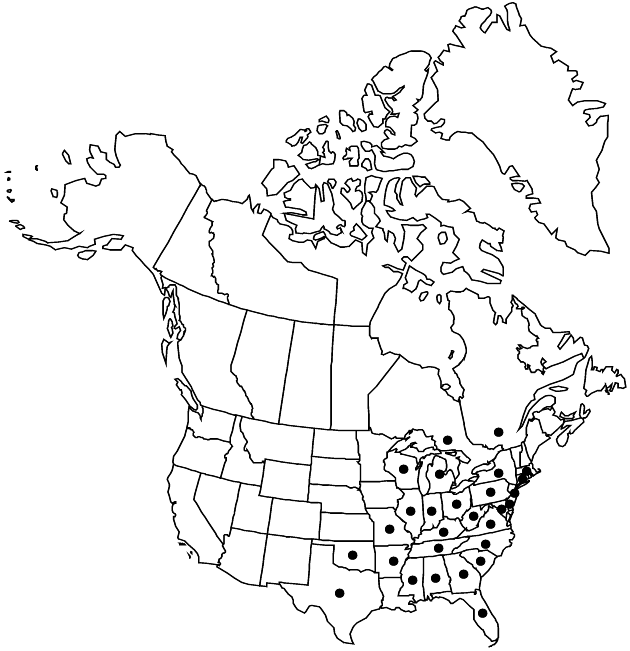Difference between revisions of "Rudbeckia fulgida"
Hort. Kew. 3: 251. 1789.
FNA>Volume Importer |
imported>Volume Importer |
||
| Line 8: | Line 8: | ||
}} | }} | ||
|common_names=Orange coneflower | |common_names=Orange coneflower | ||
| + | |special_status={{Treatment/ID/Special_status | ||
| + | |code=E | ||
| + | |label=Endemic | ||
| + | }} | ||
|basionyms= | |basionyms= | ||
|synonyms= | |synonyms= | ||
| Line 20: | Line 24: | ||
-->{{Treatment/Body | -->{{Treatment/Body | ||
| − | |distribution= | + | |distribution=Ont.;Que.;Ala.;Ark.;Conn.;Del.;Fla.;Ga.;Ill.;Ind.;Ky.;Mass.;Md.;Mich.;Miss.;Mo.;N.C.;N.J.;N.Y.;Ohio;Okla.;Pa.;S.C.;Tenn.;Tex.;Va.;W.Va.;Wis. |
|discussion=<p>Varieties 7 (7 in the flora).</p> | |discussion=<p>Varieties 7 (7 in the flora).</p> | ||
|tables= | |tables= | ||
| Line 90: | Line 94: | ||
|basionyms= | |basionyms= | ||
|family=Asteraceae | |family=Asteraceae | ||
| − | |distribution= | + | |distribution=Ont.;Que.;Ala.;Ark.;Conn.;Del.;Fla.;Ga.;Ill.;Ind.;Ky.;Mass.;Md.;Mich.;Miss.;Mo.;N.C.;N.J.;N.Y.;Ohio;Okla.;Pa.;S.C.;Tenn.;Tex.;Va.;W.Va.;Wis. |
|reference=None | |reference=None | ||
|publication title=Hort. Kew. | |publication title=Hort. Kew. | ||
|publication year=1789 | |publication year=1789 | ||
| − | |special status= | + | |special status=Endemic |
| − | |source xml=https:// | + | |source xml=https://bibilujan@bitbucket.org/aafc-mbb/fna-data-curation.git/src/bb6b7e3a7de7d3b7888a1ad48c7fd8f5c722d8d6/coarse_grained_fna_xml/V19-20-21/V21_109.xml |
|tribe=Asteraceae tribe Heliantheae | |tribe=Asteraceae tribe Heliantheae | ||
|subtribe=Asteraceae (tribe Heliantheae) subtribe Rudbeckiinae | |subtribe=Asteraceae (tribe Heliantheae) subtribe Rudbeckiinae | ||
Revision as of 20:54, 27 May 2020
Perennials, to 120 cm (stoloniferous, rosettes forming at stolon apices). Stems glabrous or moderately hirsute (branches spreading). Leaves: blades lanceolate to broadly ovate or elliptic (not lobed), herbaceous, bases attenuate to cordate, margins usually entire or serrate, sometimes lacerate, apices acute, faces glabrous or hirsute to strigose; basal petiolate, 5–30 × 1–8 cm; cauline petiolate, 2–25 × 0.5–7 cm, bases attenuate to cordate or auriculate. Heads borne singly or (2–7) in corymbiform arrays. Phyllaries to 2 cm. Receptacles hemispheric to ovoid; paleae 2.5–4 mm, (apical margins usually ciliate) apices obtuse to acute, abaxial tips usually glabrous. Ray florets 10–15; laminae elliptic to oblanceolate, 15–25 × 3–6 mm, abaxially strigose. Discs 12–16 × 10–18 mm. Disc florets 50–500+; corollas proximally yellowish green, brown-purple distally, 3–4.2 mm; style branches ca. 1.3 mm, apices rounded. Cypselae 2.2–4 mm; pappi coroniform, to 0.2 mm.
Distribution

Ont., Que., Ala., Ark., Conn., Del., Fla., Ga., Ill., Ind., Ky., Mass., Md., Mich., Miss., Mo., N.C., N.J., N.Y., Ohio, Okla., Pa., S.C., Tenn., Tex., Va., W.Va., Wis.
Discussion
Varieties 7 (7 in the flora).
Selected References
None.
Lower Taxa
Key
| 1 | Basal leaf blade lengths ± 3 times widths | Rudbeckia fulgida var. fulgida |
| 1 | Basal leaf blade lengths to 2 times widths | > 2 |
| 2 | Cauline leaves not notably smaller distally | > 3 |
| 2 | Cauline leaves notably smaller distally (except var. umbrosa) | > 4 |
| 3 | Stems densely villous-hirsute; basal leaf margins mostly coarsely crenate; cauline leaf margins sharply serrate (teeth remote); Illinois, Indiana, Ohio | Rudbeckia fulgida var. deamii |
| 3 | Stems glabrous or sparsely villous-hirsute; basal leaf margins entire or crenate; cauline leaf margins coarsely serrate to lacerate; ne United States | Rudbeckia fulgida var. speciosa |
| 4 | Ray laminae 25–40 mm; palea margins eciliate (Indiana, Michigan, Ohio) | Rudbeckia fulgida var. sullivantii |
| 4 | Ray laminae 10–30 mm; palea margins ciliate | > 5 |
| 5 | Leaf bases (basal and proximal cauline) broadly rounded to cordate (Alabama, Arkansas, Georgia, Indiana, Kentucky, Mississippi, Missouri, North Carolina, Ohio, South Carolina, Tennessee, Virginia) | Rudbeckia fulgida var. umbrosa |
| 5 | Leaf bases (basal and proximal cauline) usually acute, attenuate, cuneate, or rounded | > 6 |
| 6 | Cauline leaf blades lanceolate to ovate; ray laminae 15–25+ mm; Arkansas, Missouri, Oklahoma, Texas | Rudbeckia fulgida var. palustris |
| 6 | Cauline leaf blades oblanceolate to broadly spatulate or pandurate; ray laminae 10–15 mm; Alabama, Florida, Georgia, North Carolina, South Carolina, Tennessee, Virginia, West Virginia | Rudbeckia fulgida var. spathulata |